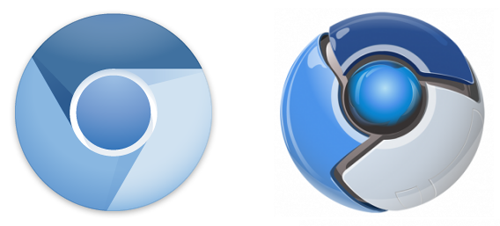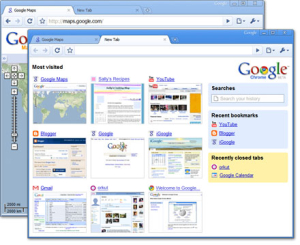Chromium cambia logo

Il browser Chromium ha cambiato logo passando da una versione 3D a linee più minimaliste. Ora ci si domanda se anche Google Chrome adeguerà il suo logo di conseguenza.

Il browser Chromium ha cambiato logo passando da una versione 3D a linee più minimaliste. Ora ci si domanda se anche Google Chrome adeguerà il suo logo di conseguenza.
Ieri alla presentazione della release candidate di Internet Explorer 9 - veloce, minimale, pronto per HTML5 - è emerso chiaramente che il rivale da tenere sotto osservazione per Microsoft non è Firefox, ma il browser di Google.
When we look at the stats for browser use worldwide, Internet Explorer has been on a slow decline, dropping from 55% a year ago to around 46% today. That's a drop of nine percentage points. Chrome, on the other hand, has been on the rise, going from 6% a year ago to nearly 16% today. Where is Firefox? Steadily holding its ground in second place with a nearly consistent 30% of the browser market.
Secondo eWeek ci sono dieci validi motivi sul perché Firefox 4 non arresterà la rincorsa di Chrome.
Uso Chrome come browser predefinito da qualche anno e Firefox è stato ormai relegato al solo testing. Non posso che essere d'accordo con questa analisi.
1. Avvio troppo lento.
A major problem with Firefox in the past has been that it starts up too slowly compared with other browsers. Mozilla obviously realized that and did a fine job, at least in Windows 7, of making Firefox 4 load far more quickly. But it's still too slow when compared with Chrome. It's not necessarily a deal-breaker - the difference is about 1 or 2 seconds - but it's noticeable enough for some users who require zippy actions to opt for Chrome over Mozilla's product.
2. Navigazione ancora troppo lenta.
A browser's ability to load pages will determine which software people will use on a regular basis to surf the Web. When comparing Firefox 4 with Chrome, it quickly becomes apparent that the latter browser does a much better job of loading pages. In some cases, large, detailed pages load nearly twice as fast in Chrome than in Firefox. Mozilla's latest browser beta is admittedly much faster than its predecessor, but until Firefox does a better job of quickly loading pages, most folks will likely opt for Google's browser.
3. Mancanza di una barra degli indirizzi multifunzione.
One of the key components in Chrome is the ability to use its address bar both for search and for typing in a URL. In Firefox 4, the functionality is similar. Users can type a URL into the address bar and go to the desired site, or they can type in a search query and get the first site listed in Google search results. That's certainly better than nothing, but it would be nice if the address bar doubled as a true search field, rather than being flanked by a search bar. It's not necessarily an annoyance, but it's just another example of Chrome doing a slightly better job than Mozilla's latest browser.
4. Interfaccia troppo simile a Chrome.
A quick comparison between previous versions of Firefox and the new iteration of the browser shows just how far Firefox 4 has come in design. It's a much nicer browser that longtime Firefox fans will like. But further inspection reveals that it looks awfully similar to Chrome on Windows 7. Not only has Mozilla consolidated menus, as Chrome did, but Firefox has also taken on a similar skin to Chrome. It's not necessarily a bad thing, since Chrome is so well-designed, but it seems rather unfortunate that Mozilla couldn't come up with something a little more unique to challenge Google's browser with.
5. Persa la facilità d'uso di una volta.
Firefox won a lot of converts because of its ease of use. In previous versions of the software, folks could easily access menus, find bookmarks and generally enjoy the efficiency of the application. In fact, Firefox was arguably better than Chrome in terms of usability. But all that has changed. Firefox 4 has jumbled menus that aren't broken out any longer. Chrome users will feel right at home, but those who enjoy having easy access to top-level menus will find Firefox 4 shocking at first glance. Firefox 4 just isn't as easy to use as earlier versions were. And that's unfortunate.
6. Spostare le schede è complicato.
It might be a small issue, but the way tabs are moved in Firefox 4 needs to be improved before the software's final build is made public. In Chrome, moving a tab is a simple matter of dragging it from one place to another. Along the way, the other tabs shift, and it's easy to see where the tab is going. But in Firefox 4, that isn't the case. The browser's tabs don't move as a page is dragged across the bar, and the only help given to the user is a simple blue arrow that is too difficult to see in Windows 7. It's nice to be able to move tabs, but if the functionality isn't smooth, it will be frustrating to users.
7. Design poco intuitivo.
One of the main problems with Firefox 4 is that its new design lacks the kind of intuitive design that users are looking for. There is a prominent address bar and the search box is still to the right of it, but with different options hidden both at the upper left of the page and to the right of the search box, too much moving around and clicking is required to find the features users really want. It seems that rather than develop a design that understands what people want to do with a browser and helps them do it more efficiently, Mozilla decided to lump everything together into a couple of menus. It's unfortunate. An intuitive design is central to a browser's success or failure. And Firefox 4 doesn't have that.
8. HTML 5 è una feature che hanno già tutti.
The addition of HTML5 support in Firefox 4 could be the browser's most desired new feature. Users will now be able to view content in the new standard no matter where they go on the Web. But excitement over the addition of HTML5 seems rather overblown. Yes, it's nice to have the standard Apple supports, but its inclusion seems like an obvious move on the part of a company that's trying to keep up with changing Web platforms. Firefox 4 was forced to support HTML5, considering that much of the competition already accommodates it in one form or another. It's nice to have it, but let's not get too excited about it.
9. La visualizzazione dei sorgenti e la gestione dei segnalibri è da migliorare.
Throughout the process of using Firefox 4, one issue continued to pop up: The browser is far simpler than previous versions in some areas, but in others, it's far more complicated. In other words, Firefox 4 is very much a tradeoff experience. On the one hand, thanks to its prominent address bar and useful search bar, it's simple and a viable alternative to Chrome. But when trying to, say, look at a page source or just view saved bookmarks, it becomes far more complicated than it needs to be. This is a major design flaw that should be addressed in the final build.
10. Sul lungo periodo Chrome ha la capacità di sviluppare maggiori potenzialità.
When it comes time to compare one browser with another, future potential must be considered. Although there is a lot of upside to Mozilla's Firefox 4, and it provides a great starting point for even better versions of the application in the future, Chrome has the most potential of any browser on the market. Not only will the software play a key role in Chrome OS, but it's fast, it's well-designed and there are several things Google can do to improve the browser far beyond any other program on the market. If future potential is a component in deciding which browser is better, Chrome wins.
For some time now, Google Chrome has been working with a number of extensions - but unofficially. That's about to change in a big way, maybe as soon as tomorrow. And some digging through backchannel chatter reveals some of Google's intentions here.
Via TechCrunch.
non è così stupefacente che ci sia molta gente in giro che non afferra appieno la differenza tra un blogger che scrive di quanto gli aggrada e come gli aggrada dentro un contesto "cooperativo", diffuso, distribuito ma non omogeneo di altre persone come lui che si scambiano informazioni e opinioni, e un giornalista che scrive in solitario attenendosi (si spera...) a criteri e vincoli professionali che sono il corrispettivo del salario che riceve. la cosa stupefacente è che quelli che non afferrano la differenza ormai siano quasi tutti blogger e per di più se-dicenti tecnologici.

Il nuovo browser di Google è un po' Firefox, un po' Safari, un po' IE 8 e un po' Flock.
Da tutti prende qualcosa, ma non rivoluziona il modo di interfacciarsi col web.
E' open source ed è stato sviluppato usando Webkit (sì, Safari gli si avvicina molto) e prendendo spunti da Firefox.
L'uscita mondiale solo per sistemi Windows è stata una scelta non felice, ma Google ci ha abituato da tempo a questa politica.
Chrome è veloce. Indubbiamente veloce. Il rendering delle pagine ottimo.
E' leggero e non è avido di memoria come il cugino/rivale Firefox.
La navigazione in incognito può essere utile al mondo del porno, funzione che tra l'altro si è già vista nella beta di IE 8, ma non mi lascia particolarmente impressionato.
Come anche la pagina iniziale, in cui viene mostrata una cronologia dei siti visitati in piccole finestre.
Da segnalare la possibilità di creare scorciatoie dei siti che stiamo visitando per trasferirle sul nostro desktop, da utilizzare poi come se fossero normali applicazioni stand-alone. Idea che ricorda da vicino Adobe AIR.
Tra le opzioni, ridotte all'osso come anche la gestione dei preferiti/segnalibri, saltano all'occhio solo i nomi delle schede: piccoli ritocchi e roba da smanettoni. Grasse risate al primo giro, ma la giostra si ferma lì.
Google Chrome promette che se durante la navigazione tra le tab una di queste dovesse bloccarsi ciò non comprometterebbe le altre, permettendo di proseguire la propria navigazione.
Qui non resta che provare. Detta così suona molto bene e risolverebbe la vita a non poche persone.
La gestione indipendente delle tab è una gradita novità, probabilmente la vera innovazione rispetto ai concorrenti.
Bisognerà studiarne le potenzialità.
Per concludere Google Chrome è un buon browser, adatto a chi vuole navigare senza troppi fronzoli, in modo semplice e veloce. Ricordiamoci che è la prima versione e tutto in futuro potrà cambiare.
Tuttavia non mostra nessuna significativa novità in grado di impensierire i browser presenti oggi sul mercato. E anzi presenta qualche lacuna di troppo.
Se ne intravedono le grandi potenzialità, ma per il momento il browser di Mountain View non sarà la mia prima scelta.
Scott McCloud ha realizzato un fumetto di 38 pagine che illustra un nuovo browser progettato da Google, nome in codice Chrome.
Il tutto spedito a Google Blogoscoped.
La realizzazione è affascinante, il progetto risulta particolarmente intrigante. Se poi ci mettete che in questo periodo Firefox mi da noie a non finire capirete il motivo del mio entusiasmo.
Il progetto e gli screenshot.